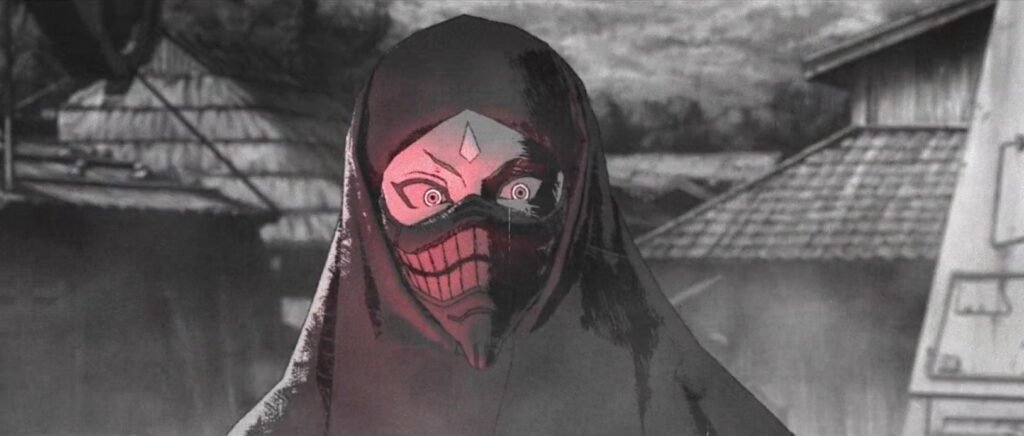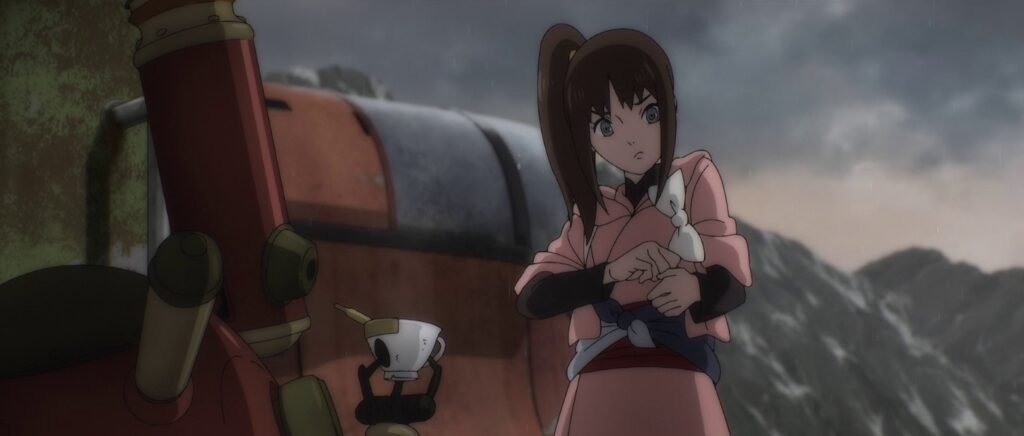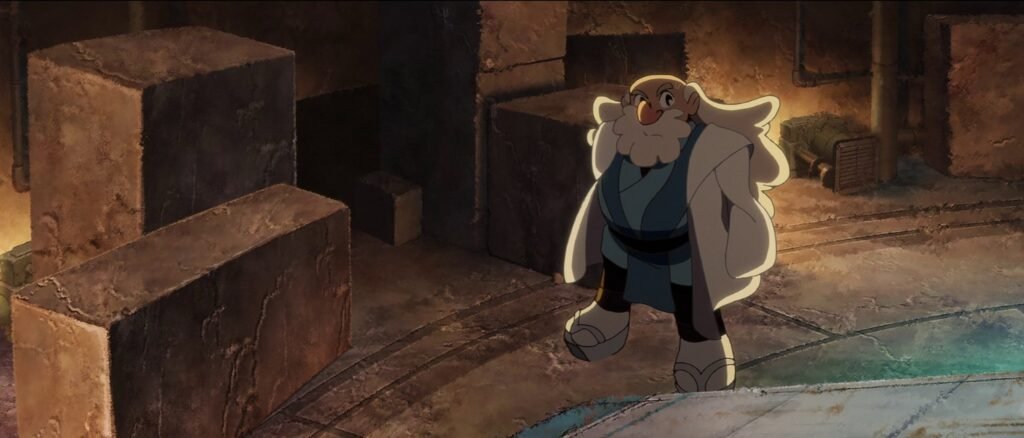Star Wars: Visions Season 1 Story :-
“Star Wars Visions” presents a varied assortment of animated vignettes that elicit a range of reactions. As is typical for an anthology series, some episodes shine brighter than others due to the diverse contributions from different animation studios. Much like “The Animatrix,” where standout episodes like “World Record” or “Detective Story” overshadow the rest, “Star Wars Visions” similarly offers a mixed bag, though the recommendation to watch the entire series remains a point of contention.
Movie Ratings
| Release Date | 22 September 2021 |
| Language | |
| Genre | Fantasy, Sci-Fi, Animation, Action |
| Episodes | 9 |
| Cast | Masaki Terasoma, Akeno Watanabe, Brian Tee, Lucy Liu, Hiroyuki Yoshino, Joseph Gordon-Levitt, Temuera Morrison, Junya Enoki, Neil Patrick Harris, Ryoko Shiraishi, Alison Brie, Asami Seto, Karen Fukuhara, Chinatsu Akasaki, Kimiko Glenn, Tsutomu Isobe, Kyle Chandler, Takaya Hashi, David Harbour, Seiran Kobayashi, Anna Cathcart, Yū Miyazaki, Henry Golding, Lynn, Jamie Chung, Chō, George Takei |
| Director | Takanobu Mizuno, Taku Kimura, Hiroyuki Imaishi, Hitoshi Haga, Kenji Kamiyama, Abel Góngora, Masahiko Otsuka, Yuki Igarashi, Eunyoung Choi |
| Writer | Takashi Okazaki, Yasumi Atarashi, Hiromi Wakabayashi, Takahito Oonishi & Hitoshi Haga, Kenji Kamiyama, Yuichiro Kido, Masahiko Otsuka, Sayawaka, Yuichiro Kido |
| Producer | Jacqui Lopez, James Waugh, Josh Rimes, Justin Leach, Kanako Shirasaki |
| Production | Lucasfilm, Lucasfilm Animation |
| Certificate | 7+ |
From a writer’s perspective, I am inclined to advocate for watching individual episodes. For die-hard Star Wars enthusiasts seeking fresh perspectives on the universe or deeper exploration of lore concepts, I would advise skipping most episodes. The series prioritizes animation, visual style, and sound over substantive storytelling, leaving little room for thematic depth. Opting to watch only a few select episodes may offer a more fulfilling viewing experience.
However, despite this dilemma, the art and animation alone warrant consideration for recommending the entire series. Even the least captivating vignettes boast striking visual flair and unique styles. Despite any narrative shortcomings, each episode delivers a visual spectacle that is sure to captivate audiences, particularly those with an appreciation for art and animation.
While some episodes may lack substance, the visual extravagance of “Star Wars Visions” remains its strongest selling point. Even episodes with tonal inconsistencies or questionable adherence to Star Wars canon manage to dazzle with their over-the-top action and vibrant animation. The series undoubtedly appeals to fans of visual storytelling, though individual preferences may vary.
Ep 1: The Duel
Visions starts off with a bang, setting a high standard right from the beginning. The Duel stands out as a favorite among many viewers, including myself. It’s a must-watch episode solely for its stunning art style.
Drawing inspiration from classic samurai tales, The Duel fully embraces this influence. Its Sin City-esque black and white visuals, accented by vibrant red highlights, create a captivating visual experience. It’s no surprise, considering the studio’s track record with the Jojo anime. The episode expertly showcases classic samurai themes and motifs, culminating in an epic duel.
There’s little more to say about The Duel other than praising its impressive execution. If you’re only able to watch one episode, make it The Duel. It sets a high bar that may not be surpassed by the others.
Ep 2: Tatooine Rhapsody
Following the standout episode of Visions, we encounter one of its weakest entries. Unfortunately, Tatooine Rhapsody left me underwhelmed. In contrast to the impressive and visually striking art of The Duel, Tatooine Rhapsody opts for an exaggerated chibi style that didn’t resonate with me. The main character’s appearance left me uncertain whether they were an adult or a child, a confusion that persisted until the end.
The discordance of the art style made it challenging for me to connect with the episode, resulting in a lack of engagement with its plot and concept. The story revolves around a band attempting to perform amidst constant interruptions by bounty hunters. It culminates in a garage rock concert as a final wish before facing a firing squad. While the premise is intriguing, I found it difficult to invest in, and the music didn’t capture my interest either. Consequently, the series experienced a decline after its strong start, with Tatooine Rhapsody falling short of expectations. Everything else falls somewhere between the highs and lows of these two episodes.
Ep 3: The Twins
Recall when I mentioned an episode that felt tonally nonsensical and uncharacteristic of Star Wars? That’s precisely what we get with this entry from Trigger. If you’re familiar with the studio behind Gurren Lagann and Kill la Kill, you know they have a penchant for unconventional storytelling. The Twins throws caution to the wind, disregarding established rules and conventions not only of the Star Wars universe but also of space itself. It barely acknowledges the source material before diving into hyperdrive-powered lightsaber battles atop a Star Destroyer in a vacuum.
It’s absurdity at its peak. Did it bother me? Not really. The episode’s ridiculously over-the-top, flashy, and excessive stylized action had me grinning like a fool. While it’s worth watching for the spectacle alone, those who take Star Wars seriously might find their brains melting
Ep 4: The Village Bride
Despite my tendency to mistakenly type “Village Bridge” every time, this episode quickly became a personal favorite of mine. The art and animation were stunning, featuring a naturalistic style and breathtaking vistas. What truly stood out, however, was the music. It complemented the visuals so perfectly that for a moment, I felt like I was listening to NieR’s soundtracks.
While the plot and writing didn’t reach spectacular heights like some other episodes, every other aspect of this episode shone brightly. Overall, it stood out as a definite highlight of the series.
Ep 5: The Ninth Jedi
Among all the episodes in the anthology, “The Ninth Jedi” stood out to me as feeling like the pilot of a Star Wars arc that I would eagerly follow. It presents an opportunity to explore a new period in the timeline, one with different power dynamics and a scarcity of established Jedi or Sith, reminiscent of the Legends era before Disney’s overhaul.
The plot centers on the rediscovery of the lost art of lightsabers. Newly forged lightsabers are distributed to seven Jedi who respond to the call, courtesy of a mysterious eighth Jedi. Meanwhile, the Force-sensitive daughter of the swordsmith endeavors to deliver the blades to them, hoping they will aid in saving her father. While the premise is simple, it is executed with stunning visuals, captivating action sequences, intricate choreography, and compelling character designs.
Although “The Ninth Jedi” didn’t captivate me as intensely as “The Duel” or “Village Bride” did, it certainly left a lasting impression. These three episodes stand out as my favorites from the series and are easy recommendations. However, there’s one more episode worth highlighting…
Ep 6: T0-B1
Because this episode boasts the most distinct animation style of the collection. T0-B1 (pronounced as Tobi) immediately establishes its premise: What if Astro Boy existed in the Star Wars universe? The titular droid exudes endearing charm with its child-like innocence, a quality reflected in the delightful artistry throughout the episode.
While T0-B1 didn’t leave as profound an impact as the aforementioned top three favorites, its unique style and infectious positivity were undeniable. It brought a smile to my face—what more could I ask for? That alone made it a worthwhile viewing experience.
Ep 7: The Elder
The Elder presents a mixed bag of experiences. Once again, it heavily delves into samurai mythology and aesthetics. The latter part of the episode successfully evokes the atmosphere of a Kurosawa film, albeit in color, which I found commendable. However, the first half feels rather slow and uninspired, featuring a plain and “classic” anime style compared to the rest. I was anticipating an early plot twist, but the episode played its premise straightforwardly, which may have been for the best considering Star Wars’ track record with subverting expectations.
While The Elder had its moments, it could have achieved them in a more concise manner with less exposition. Without the visual flair to compensate, it might be considered one of the less memorable episodes.
In hindsight, I realized that this episode was also produced by Trigger. However, it didn’t quite exhibit the distinctive style and feel typically associated with Trigger’s productions.
Ep 8: Lop and Ocho
By the time I reached Lop and Ocho, I might have been feeling the effects of binge-watching the series. I found myself zoning out or checking Discord frequently. While the episode explores an important theme about the significance of found family over blood family, I don’t think it was executed particularly well. Perhaps the tight timeframe or the focus on the more climactic moments of the story contributed to this.
However, the visuals in Lop and Ocho are undeniably impressive. The backgrounds and vistas are especially noteworthy, second only to Village Bride (got it right this time!). This episode heavily emphasizes samurai motifs through clothing and iconography rather than swordplay. While this style might appeal to some viewers more than others, it received mixed feedback from my viewing party.
Ep 9: Akakiri
The final episode of the season solidified my overall impression of Star Wars Visions: heavy on style, light on substance. Akakiri follows the familiar samurai-inspired narrative, resembling a rehashed version of Anakin’s fall. While it introduces a few twists to the formula, they don’t effectively convey the concept, and the ending falls flat for me.
However, Akakiri excels in its visual style. The setting evokes a grungy, low-tech feudal Japan vibe, which is portrayed exceptionally well through the art style. The aesthetics, apart from the lightsabers, don’t quite align with the typical Star Wars look, but they stand out in their own right. Despite its visual appeal, the episode lacked the vibrancy to evoke more than a lukewarm response from me.
In summary, Star Wars Visions left me underwhelmed. I stumbled upon it with little prior knowledge, and it didn’t change my perspective on modern Disney franchises. While the series allowed creativity to flourish in its animation and art, it fell short in terms of storytelling and originality. Nevertheless, spending an evening watching Visions isn’t the worst way to pass the time, even though there are better alternatives that might not be as visually stunning.


